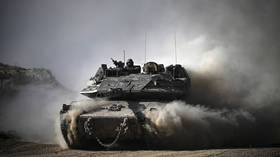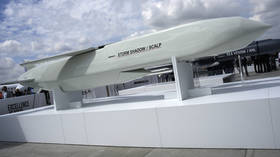Five years since the demise: How the world is changing without the INF Treaty

Friday marks five years since the termination of the Intermediate-Range Nuclear Forces (INF) Treaty, signed by the Soviet Union and the US in 1987. For a long time, the consequences of this step were overshadowed by other tensions in the international arena: public attention was focused on different topics and it seemed that ‘post-INF’ issues interested only experts in the sphere itself.
However, the fifth anniversary is being celebrated in a truly “grand manner.” The US offered a “gift” to Russia by announcing plans to begin “episodic deployments” of its ground-launched missiles in Germany in 2026. Russia didn’t slack on the matter: President Vladimir Putin responded that if these plans are implemented, Moscow will lift the unilateral moratorium on the deployment of its own intermediate-range missiles. Russia’s Ministry of Foreign Affairs did not rule out that these could be nuclear. Such an “exchange of pleasantries” signifies a new “missile crisis” that may surpass those of the 1970s and ‘80s that eventually led to the signing of the original treaty.
At that time, the deployment of new nuclear missiles in Europe led to the deterioration of Soviet-US relations to their lowest point since the 1962 Cuban Missile Crisis. The issue was solved radically – by signing the INF Treaty the US and the USSR prohibited themselves from having any (either nuclear or non-nuclear) ground-launched missiles with a range of 500 to 5,500 kilometers. From a military-strategic point of view, this put the US in a more advantageous position. Firstly, the USSR eliminated twice as many rockets – 1,846 compared to 846 by the US. Secondly, air- and sea-launched missiles of similar range – the United States’ key instrument of power projection – were not included in the agreement.
The Soviet leadership consented to such conditions in large part due to political reasons – back then the Kremlin believed that Soviet-US relations would eventually reach a new level and weapons would no longer play a key role in ensuring security. However, gradually this mood changed and Moscow increasingly criticized the 1987 deal. Putin eventually called the treaty “unilateral disarmament”.
The new Russian Federation also expressed concern over American compliance. Nevertheless, Moscow’s rhetoric did not exceed certain limits: the issue of terminating the agreement was never raised at the highest level. The storm clouds started to gather in the mid-2010s, when the US raised concerns that, according to its information, Russia violated the treaty and tested a ground-launched cruise missile with a range of over 500 km. Subsequently it was revealed that the missile in question was the 9M729, which is part of the Iskander system.
Donald Trump’s presidential administration named Russia’s development of the 9M729 as the official reason for launching the process of withdrawal from the INF Treaty in February 2019. However, in reality, the reasoning was more complicated. Almost simultaneously with the emergence of complaints about Russia’s compliance with the INF Treaty, a major discussion broke out in the US about the development of China’s capabilities. Unlike Moscow and Washington, Beijing wasn’t bound by the INF Treaty and therefore could develop ground-based missiles without breaching any international prohibitions. By the mid-2010s, these weapons formed the backbone of China’s missile arsenal; in 2017 the Commander of the US Indo-Pacific Command, Admiral Harry Harris, estimated that “approximately 95%” of those missiles would violate the INF if China were a signatory.
As a result, the Americans started to view Beijing’s capabilities as a key issue that affected the balance of power in Asia-Pacific. Chinese ground-launched DF-21D and DF-26 missiles earned the notable nicknames “carrier killer” and “Guam killer” in the US. Even when the INF was still in force, many American experts speculated about the need to withdraw from it or at least to revise its terms so that the US could develop and deploy its own ground-based missile systems in the region as a counterbalance to China.
Here, it is important to briefly outline the advantages of ground-based missiles compared to their air- and sea-launched counterparts. First of all, surface-launched missiles can be maintained at a higher state of combat readiness. While it takes time for aircraft and ships to deliver their missiles to launch areas, ground-based systems are located close to their launch sites and therefore can be used within a very short time. With these projectiles, there’s also no need to overcome the enemy’s anti-airсraft and anti-ship capabilities to carry out a launch. Other advantages include reduced dependence on infrastructure, high firepower ensured by rapid reloading, and increased survivability due to the potential for missile dispersion. Although lacking the mobility of air- and sea-launched systems, ground-based missiles may be an effective tool for preventing the enemy from establishing control over the battlefield.
In the US, this view was shared even by high-ranking military officials who did not advocate withdrawing from the INF. In 2017, then-Vice Chairman of the Joint Chiefs of Staff, General Paul Selva, said that “there are no military requirements we cannot currently satisfy due to our compliance with the INF Treaty.” However, he noted that “ground-based systems would increase both the operational flexibility and the scale of our intermediate-range strike capabilities.” The desire to obtain such “flexibility” and “scale” that may be useful against Russia and China as well as smaller powers like Iran or North Korea, formed the main reasoning behind the decision to withdraw.
In addition to military advantages, ground-launched missiles also carry symbolic value. Unlike air- and sea-launched missiles, ground-based missiles emphasize the permanent military presence of the country that placed them and its readiness to protect regional allies. This means that the actions of the US are also aimed at uniting its allies around the goal of deterring China and Russia.
However, this “military-symbolic mechanism” is not a hard science and may not lead to the results expected by Washington. We must keep in mind that both Russia and China are capable of balancing American’s new missile capabilities with countermeasures. Russia’s capabilities are particularly wide-ranging – unlike China, it can threaten US territory with intermediate-range missiles deployed in its own northeastern regions.
The opinions of American allies should also be taken into account. Some German experts have already criticized the decision to deploy US missiles, noting that it was made without prior public discussions domestically and might backfire. It is possible that further developments might provoke increased criticism both in Europe and Asia.
Eventually, the consequences of US missile deployments will depend on whether the military or the symbolic aspect comes to the forefront. If the US limits itself to deploying a small number to symbolize its “boots on the ground”, there is a chance of preventing the new arms race at an early stage. However, if hundreds of missiles will be deployed in order to ensure Washington’s total operational dominance, there is a risk of an unprecedented escalation – which, of course, it would be best to avoid.















